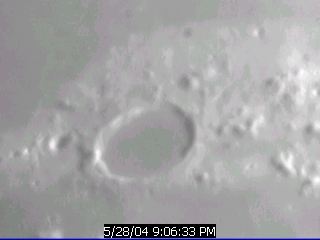
Tonight, I wanted to compare the sensitivity of three video cameras:
We received the PC164C just a few days ago, so this would be first time I would have a chance to use it. Tracy Davis was using the 12-inch telescope to observe an asteroid, so I placed these cameras on our 16-inch f/15 Cassegrain telescope. At some point, I'd like to do another set of tests with a focal reducer....
The night was clear, but bright, with a first quarter moon high in the South. It was windy, too, with gusts occasionally shaking the whole telescope. This would have been a good night to have a dome instead of a roll-off shed. I didn't spend a great deal of time focusing in any of the tests, since the air was so unsteady.
I started by focusing on the Moon, which was at first quarter high in the sky. The crater Plato seemed like a good target. Here's an image with the Astrovid 2000, in 320x240 mode.

In this image, I set the shutter speed and gain to some intermediate values. The longest diameter of the crater is
(98, 155) to (195, 127) or 101 pixels
Next, I put on the Astrovid PlanetCam. Here is its version of Plato, with the gain turned all the way down.
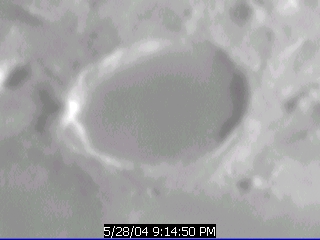
In this case, the longest diameter is about
(73, 107) to (247, 85) or 175 pixels
a factor of 1.74 times larger than the Astrovid 2000.
Hmmm. The manufacturer's specs indicate that the pixel sizes are
Astrovid 2000 8.4 x 9.8 microns
Astrovid PlanetCam 4.75 x 5.55 microns
which yields a ratio of 1.77 in the long direction. Okay,
this all makes sense.
I wanted to use an open cluster as the real test for the night, but there were none easily visible at the time. Rats. I settled for Jupiter and its moons.
Jupiter's moons can be seen in just about any video camera. All 4 Galilean satellites were gathered to the East of Jupiter on this night, arranged like so:

On this night, there was just one star close to Jupiter which I could also use as a test. The star GSC 0846-0962 = TYC 846-962-1 was about 158 arcseconds away from Jupiter on its "other" side, opposite to the moons. This star has magnitudes Bt=10.6 and Vt=10.2 from Tycho-2, and P=9.92 from the GSC. The star a bit to the north, GSC2.2 N2031302149, is much fainter, at B=13.6 and R=12.2. I didn't expect to pick it up at all.
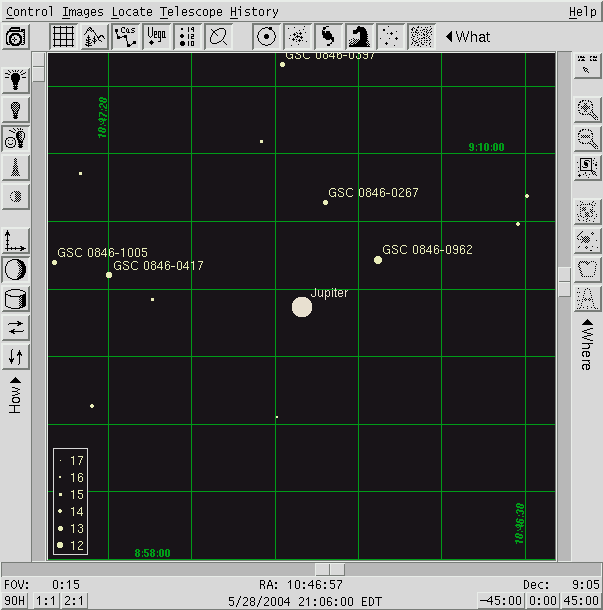
First, let's look at an image from the Astrovid PlanetCam. I set the gain to its maximum value and snapped this picture (which I have flipped and zoomed by a factor of two):
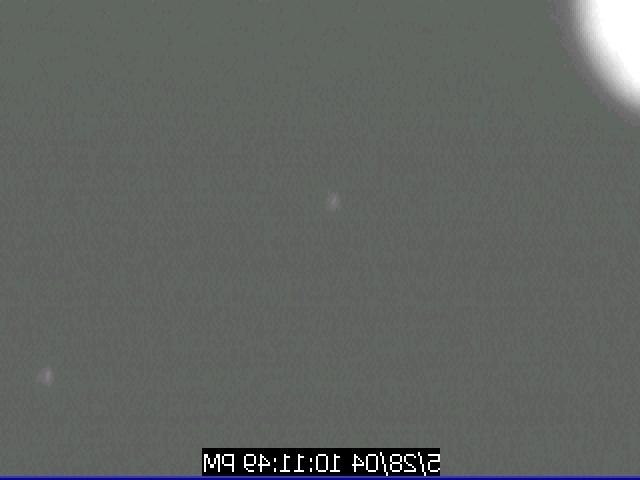
The two moons are Io (mag 5.7 according to XEphem) and Europa (mag 5.8). Each is clearly visible, but the signal is pretty darn low. The background level is about 98 counts, and the peak of each moon is about 120 counts (with saturation at 255). The distance between the moons is about 166 pixels. Since the actual angular distance was about 48.87 arcseconds, this means each pixel subtends about 0.29 arcseconds, and the field of view is 94 x 71 arcseconds.
Next, a picture from the Astrovid 2000 (likewise flipped and zoomed). I set the shutter speed and gain to their maximum values.
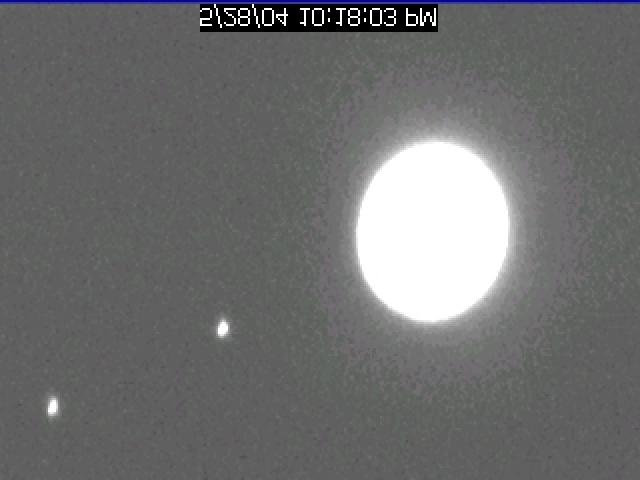
Both moons are detected strongly. Despite being out of focus, each is saturated. The distance between the two moons is about 93 pixels. Since the angular separation of the moons was about 48.87 arcseconds, this means each pixel is about 0.53 arcseconds in size, and the field of view is about 168 x 126 arcseconds (or 2.8 x 2.1 arcminutes).
When I moved the telescope over the other side of Jupiter, to look for the nearby star, I was barely able to detect it visually on the computer's monitor. Here's a (flipped, zoomed) image. I can't really see the star now -- it should be somewhere in the upper-right portion of the image.
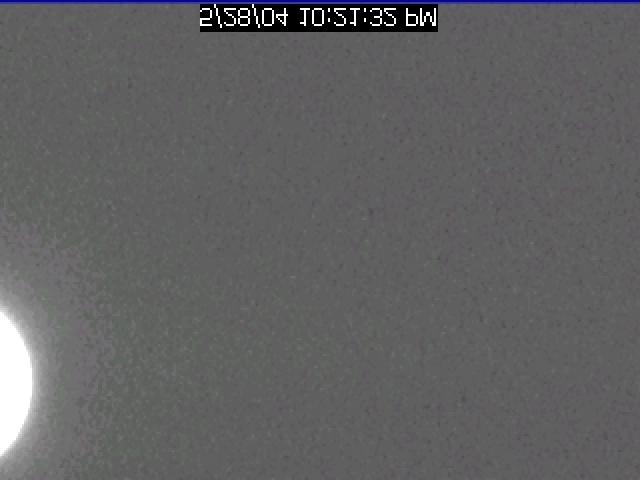
Finally, I placed the SuperCircuits PC164C low-light monochrome video camera on the telescope. Here's its first image, showing Jupiter, Io and Europa:
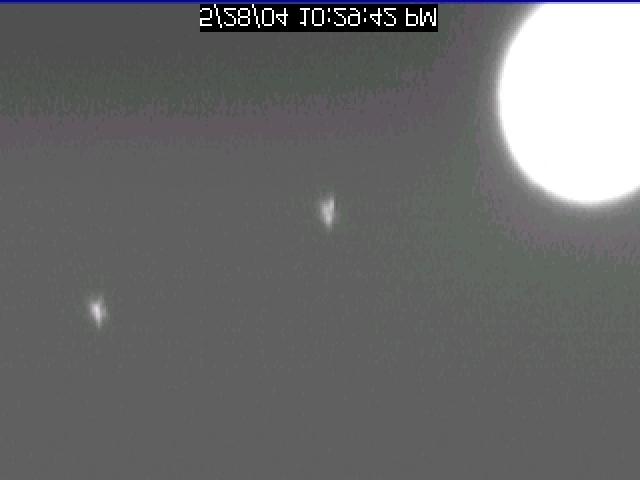
I guess I happened to pick a moment of particularly bad seeing. This camera has a automatic gain adjustment. Whenever Jupiter itself came into the field, it decreased the gain greatly. Thus, this particular image isn't a fair test of its sensitivity. However, we can get an idea for the pixel scale: Io and Europa are about 125 pixels apart, which at this time corresponds to 48.87 arcseconds. That yields a pixel scale of about 0.39 arcseconds per pixel, and a field of view of about 125 x 94 arcseconds.
Now, when I moved the telescope to the west of Jupiter to look for the nearby star, this is what I saw (flipped and zoomed):

Jupiter is just off the screen to the lower left, so that the camera's gain would revert to its maximum level. The star GSC2.2 N2031302149 is clearly, though faintly visible, in the upper right corner. Hooray!
Here are two animated GIFs showing short movies, to give you some idea of the terrible seeing and the clarity of the detection. I didn't zoom or flip the GIFs, so the star is in the lower-right corner instead of the upper-right corner.
I tried slewing to the north to see if I could detect the fainter star, but it was invisible on the monitor.
Based on these simple tests, I can summarize the performance of these three video cameras on our 16-inch f/15 telescope as follows:
Camera pixel size field of view limiting mag
(arcseconds) (arcseconds) (very rough)
--------------------------------------------------------------
Astrovid PlanetCam 0.29 94 x 71 6
Astrovid 2000 0.53 168 x 126 8-9
SuperCircuits PC164C 0.39 125 x 94 10-11
--------------------------------------------------------------